Mango – just hearing the name of this delicious fruit makes your mouth water. It’s hard to find anyone who doesn’t enjoy eating a juicy, sweet mango! Choosing the perfect ripe mango can be tricky, especially if you’re not familiar with different varieties of mangoes.
With so many kinds available, it can feel a bit overwhelming to figure out which one to pick. But don’t worry, here we break down the process of choosing a ripe mango into simple, easy-to-follow steps.
So are you ready for a tropical treasure hunt? 🌴🥭 Let’s dive into the world of mangoes and discover how to pluck the perfect one!
Table of Contents
Some challenges are faced in selecting good ripe Mangoes
Imagine you’re standing in the fruit aisle, staring at a pile of mangos. You want to pick the best one, but you have no idea how. You wonder, “Is this mango ripe? Will it be sweet and juicy, or hard and sour?” Choosing the perfect mango can be really tricky and confusing, especially since there are so many different varieties to pick from.
The excitement of picking Mangoes
Imagine walking into a grocery store or a farmer’s market, only to be faced with rows upon rows of mangoes. Each one looks slightly different, and you’re not sure which one to choose. You start to feel overwhelmed, wondering if you’ll ever find the perfect mango.
Sometimes rock rain spoils the taste of mangoes but it is not obvious from above. Even if there is an insect inside the mango, it cannot be eaten.
No one wants to take home a mango only to find it’s either rock-hard or mushy. A bad mango can ruin your snack or recipe. It’s frustrating to spend money on fruit that doesn’t taste good.
But don’t worry, picking the perfect mango doesn’t have to be a guessing game. You just need to know some tricks, and that’s exactly what I’m here to help with.
Solution: How to Pick a Mango
Here’s how to pick a ripe, delicious mango every time. Follow these simple steps and soon you’ll be a mango-picking pro!
Mango Variety Spotlight
First off, let’s dive into the different types of mangoes out there. There are many different varieties(about 2000) of mangoes in the world, each with its own unique characteristics. It’s important to look up information about the specific type of mango you want so you can get it when it’s the most delicious.
If you’re in South or Southeast Asia, like in India, Bangladesh, Myanmar, the Philippines, or Japan, you’ll probably come across a wide range of mango varieties. Here are a few common varieties you might find at the store(in the U.S):
Let’s meet some of our mango stars:
- Alphonso (a.k.a. King of Mangoes): Golden-yellow, buttery, and oh-so-regal. Alphonso mangoes are like a tropical sunset in your mouth. They’re the Beyoncé of mangoes—flawless!
- Kesar: Smaller, saffron-hued, and packed with flavor. Kesar mangoes are like a spicy salsa dance on your taste buds. Ole!
- Chaunsa: Green on the outside, but pure sunshine inside. Chaunsa mangoes are juicy, tangy, and a bit mysterious. They’re the James Bond of mangoes—shaken, not stirred.
- Ataulfo (Honey Mango): Small, yellow, and curved. Very sweet and creamy when ripe.
- Haden: Red and green with yellow accents. Firm and slightly fibrous with a rich, sweet flavor.
- Tommy Atkins: Dark red with green and orange accents. Less sweet, with a firm texture and more fiber.
- Kent: Mostly green with a dark red blush. Juicy, less fibrous, and sweet.
- Keitt: Large and green, even when ripe. Sweet, juicy, and less fibrous.
Each variety has its own special flavor and feel. So you might want to sample a few to find out which one you prefer the most. Trying different kinds can help you discover the one that you enjoy the best.
How to Pick a Ripe Mango: The Mango Quest Begins
Now let’s know the details of picking a ripe mango.
1. Look at the Color
Different varieties have different ripe colors. For example, a ripe Alphonso mango is usually orange-yellow in color, and Ataulfo mangos turn deep golden yellow when ripe. Kent mangos remain green even when they are ripe, but they might have a hint of red on them. Don’t rely solely on color because it varies by variety.
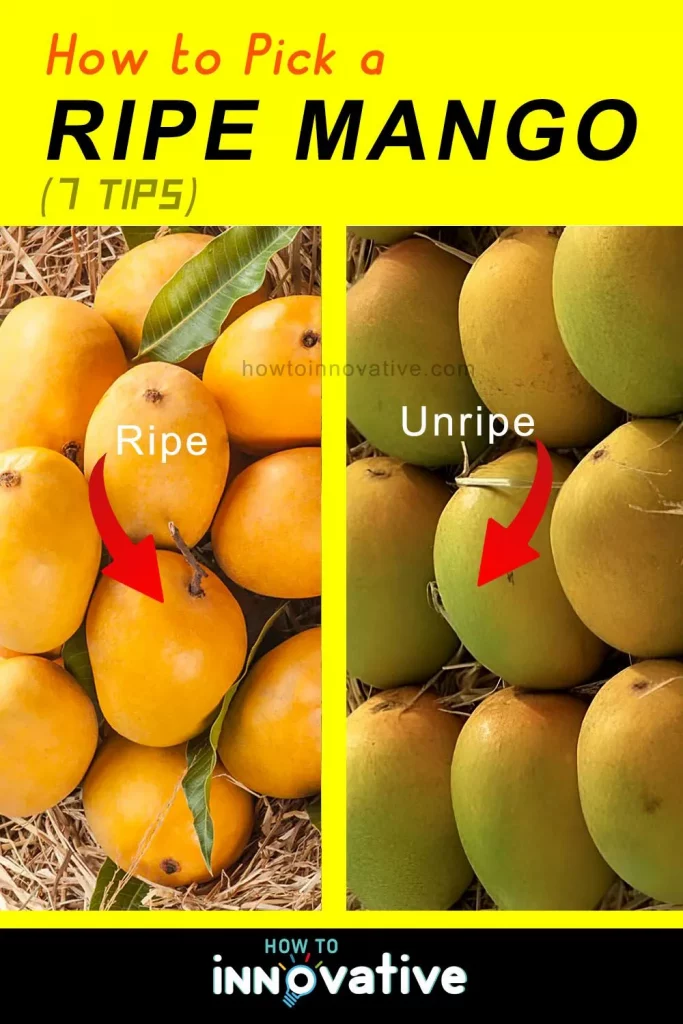
2. The Mango Touch Test: Check the Softness
Gently cradle a mango in your palm. Give the mango a gentle squeeze. A ripe mango will give slightly under pressure, similar to a ripe peach or avocado. If it’s rock-hard, it’s not ready yet. If it’s too soft, it might be overripe. Trust your fingers—they know the mango groove.
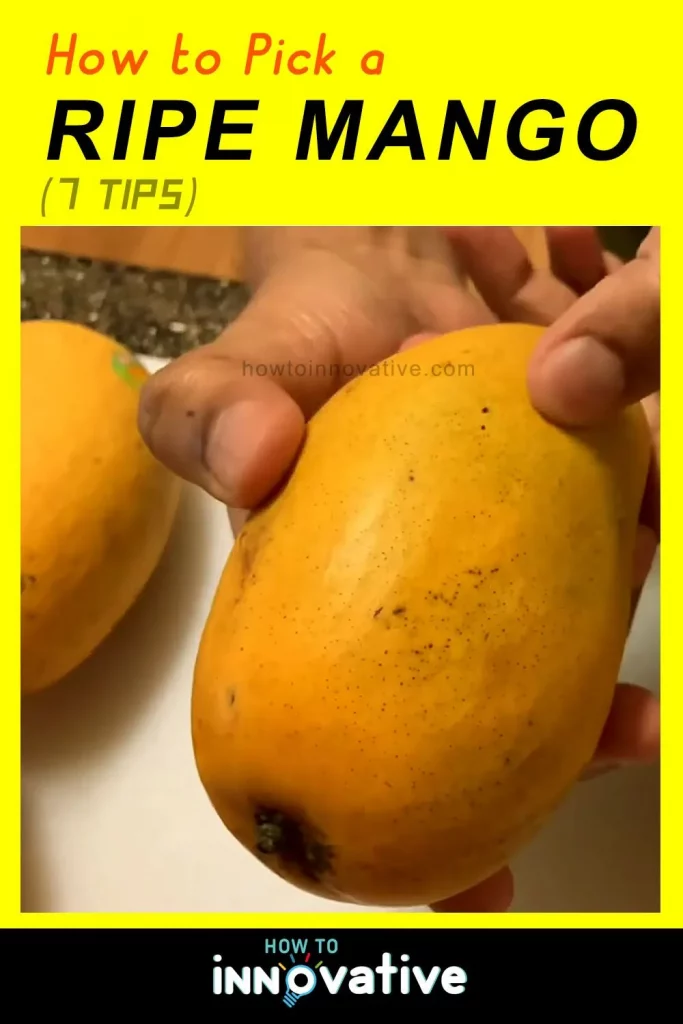
3. Check for Wrinkles
Wrinkles on the skin can be a good sign, especially for Ataulfo mangos. A few wrinkles mean the mango is very ripe and sweet.
4. Smell the Stem
Ah, the sweet serenade of mangoes! Bring the fruit close to your nose. Sniff near the stem end. A ripe mango will have a sweet, fruity aroma near its stems. Different varieties of mango have different sweetness and fruity aroma. If it doesn’t have any smell, it probably isn’t ripe yet.

5. Check the Weight
A ripe mango will be heavy for its size. Avoid mangoes that are too light or too heavy, as they may be unripe or overripe.
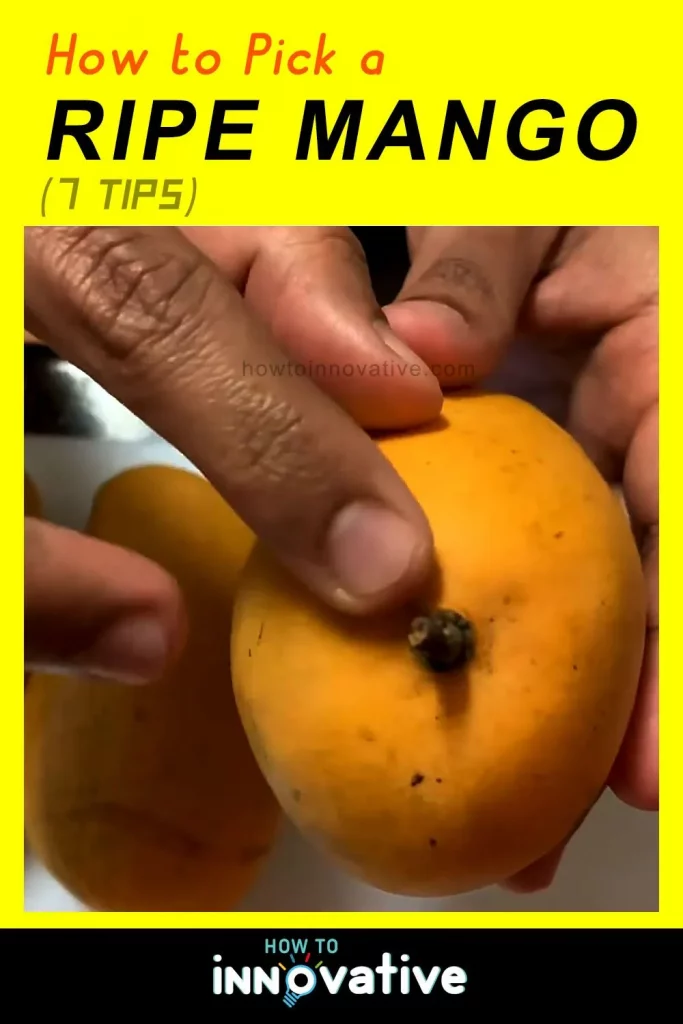
6. Check the Scent
A ripe mango will have a sweet, fruity scent. Avoid mangoes with a sour or unpleasant smell, as they may not be ripe yet.

7. Avoid Defects
Check for black spots, mold, or other blemishes. These can indicate the mango is overripe or damaged.
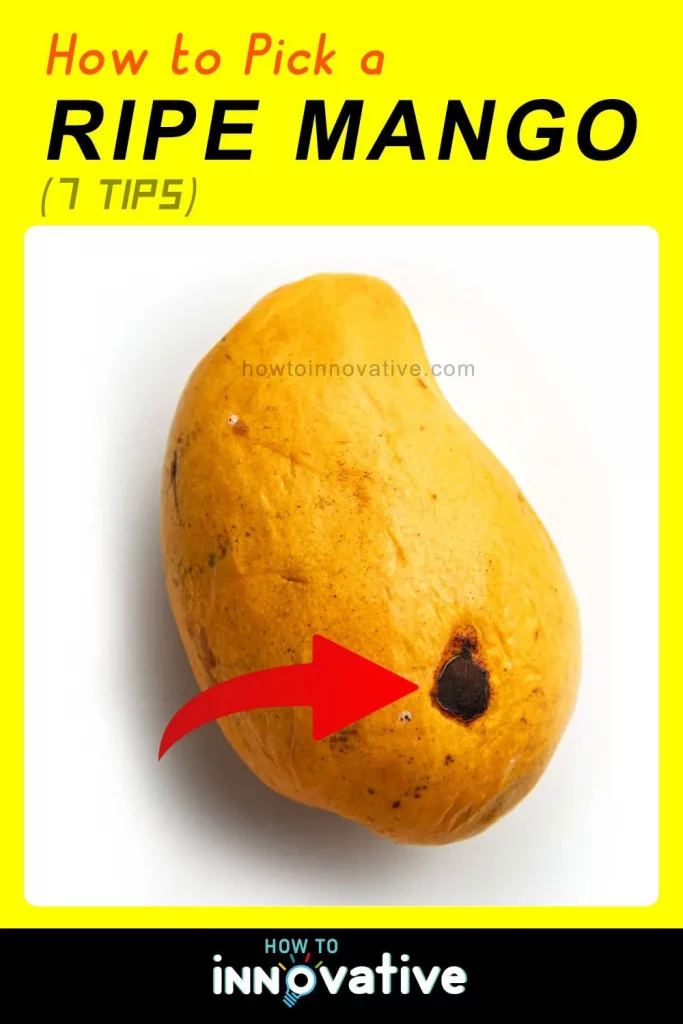
Pluck with Care
When you spot the chosen one, hold it gently and twist it off the stem. No Hulk moves, please! We don’t want bruised mangoes. Support it with your other hand.
Action: Mango Picking
Now that you know how to pick a ripe mango, it’s time to put your new skills to the test. Next time you’re at the grocery store or a farmer’s market, follow these steps to find the perfect mango.
Don’t get discouraged if you don’t pick the perfect mango every time. With a little practice, you’ll be a mango maestro! The more varieties of mangoes you buy and eat, the better you can choose the best ones.
Appreciate the Art
Back home, slice your mango with precision. Revel in its golden flesh. The juice might dribble down your chin—embrace it! Mangoes are messy, but that’s part of their charm.
Enjoy your mango solo or share it with friends. Make mango lassis, salads, or simply savor it as nature’s candy. Spread the mango love—it’s contagious!
Conclusion: Mango Mastery
Congratulations, mango maestro! You’ve unlocked the secrets of mango picking. Remember, it’s not just fruit; it’s a tropical adventure.
Picking a mango doesn’t have to be difficult. By knowing the variety and using your senses of sight, touch, and smell, you can pick a ripe, delicious mango every time. Next time you’re at the store or mango farm, use these tips and enjoy the sweet reward of a perfect mango.
I hope this mango-filled adventure brings a smile to your face! If you need more fruity wisdom or have any other quests, feel free to ask.

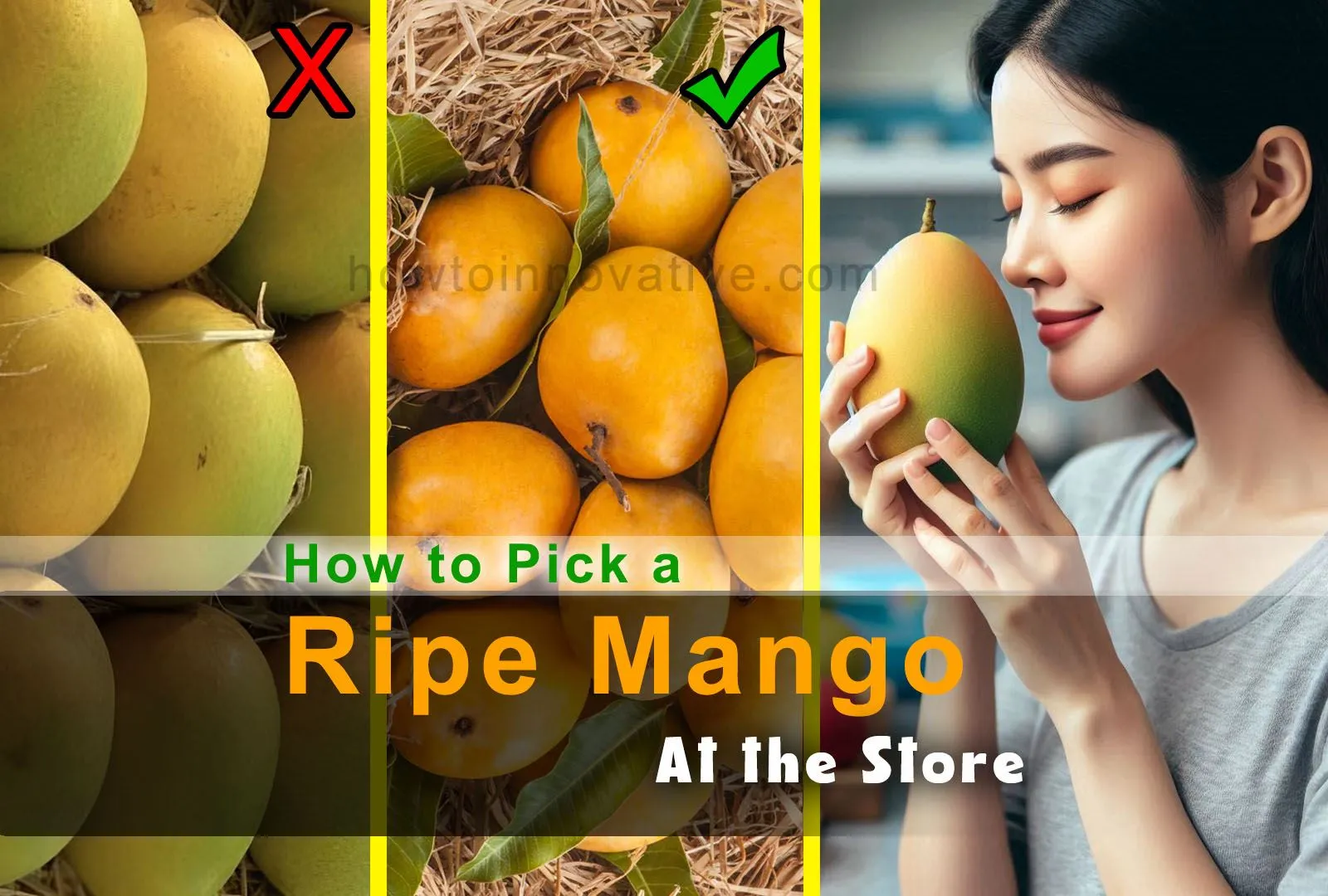


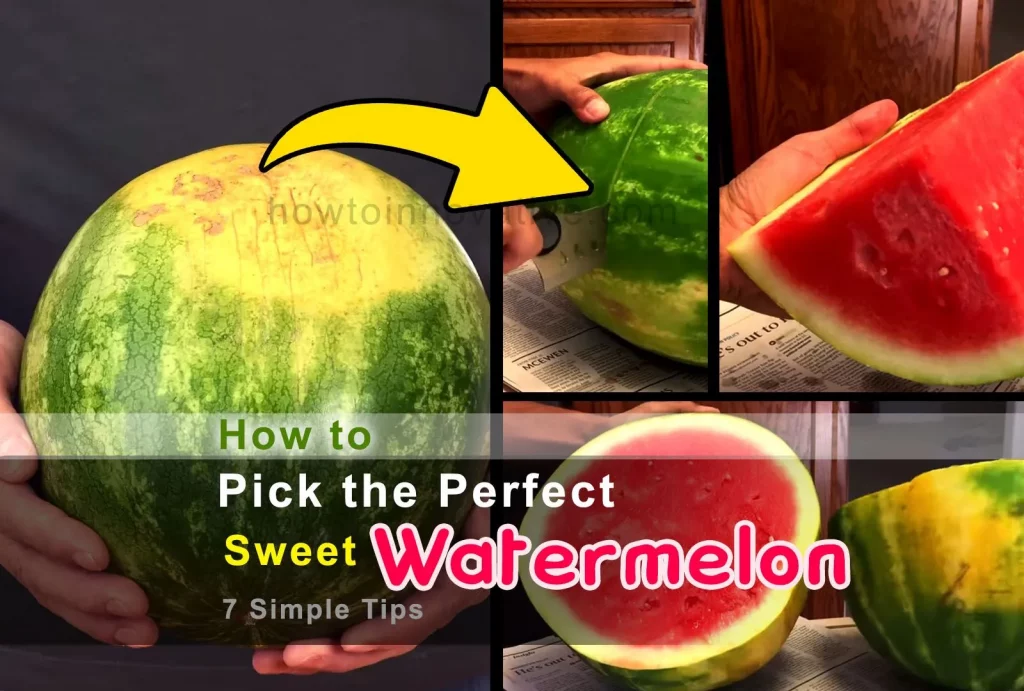
![How to Grow Potatoes in a Bucket [5-Gallon] A Step-by-Step Guide](https://howtoinnovative.com/wp-content/uploads/2024/05/How-to-Grow-Potatoes-in-a-Bucket-5-Gallon-A-Step-by-Step-Guide-1024x691.webp)